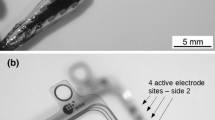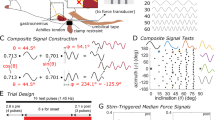Abstract
Intraoperative nerve action potential (NAP) recording permits direct study of an injured nerve for functional assessment of lesions in continuity. Stimulus artifact contamination often hampers NAP recording and interferes with its interpretation. In the present study, we evaluated the artifact reduction method using alternating polarity in peripheral nerve recording. Our study was conducted under controlled conditions in laboratory animals. NAPs were recorded from surgically exposed median or ulnar nerves. For the artifact reduction method with alternating polarity, two sequential recordings, one with normal and one with reversed stimulus polarity, were acquired and the signals from this recording pair were averaged. Simulation was also performed to further evaluate the effects of alternating polarity on the waveforms. The results are as follows: First, we found that this method worked for recordings with unsaturated electrical stimulus artifacts. Second, slightly unequal latencies occurred in an NAP pair, and this inequality contributed to a minimal loss of NAP amplitudes when averaging the two recordings. Third, perfect artifact cancelation and minimal signal loss were also demonstrated by simulation. Finally, we applied the method during nerve inching and demonstrated its usefulness in intraoperative NAP recordings as the method made the recording more resilient to short conduction distances. Thus, our findings demonstrate that this artifact reduction method can be used as a supplemental tool together with our previously described bridge grounding technique or the nonlifting nerve recording configuration to further improve intraoperative peripheral nerve recording. The method can be applied in clinical settings.





Similar content being viewed by others
Data availability
All authors made sure that all data and materials support the published claims and comply with field standards. All raw data will be available upon request.
References
Simon NG, Spinner RJ, Kline DG, Kliot M. Advances in the neurological and neurosurgical management of peripheral nerve trauma. J Neurol Neurosurg Psychiatr. 2016;87:198–208.
Crum BA, Strommen JA. Peripheral nerve stimulation and monitoring during operative procedures. Muscle Nerve. 2007;35:159–70.
Kline DG, Hackett ER, May PR. Evaluation of nerve injuries by evoked potentials and electromyography. J Neurosurg. 1969;31:128–36.
Kline DG, Happel LT, Lecture P. A quarter century’s experience with intraoperative nerve action potential recording. Can J Neurol Sci. 1993;20:3–10.
Nair DG. Intraoperative mapping of roots, plexuses, and nerves. J Clin Neurophysiol. 2013;30:613–9.
Oberle JW, Antoniadis G, Rath SA, Richter HP. Value of nerve action potentials in the surgical management of traumatic nerve lesions. Neurosurgery. 1997;41:1337–42.
Robert EG, Happel LT, Kline DG. Intraoperative nerve action potential recordings: technical considerations, problems, and pitfalls. Neurosurgery. 2009;65:A97-104.
Wu G, Belzberg A, Nance J, Gutierrez-Hernandez S, Ritzl EK, Ringkamp M. Solutions to the technical challenges embedded in the current methods for intraoperative peripheral nerve action potential recordings. J Neurosurg. 2019; 1-10.
Krarup C, Loeb GE, Pezeshkpour GH. Conduction studies in peripheral cat nerve using implanted electrodes: II. The effects of prolonged constriction on regeneration of crushed nerve fibers. Muscle Nerve. 1988;11:933–44.
Morita G, Tu YX, Okajima Y, Honda S, Tomita Y. Estimation of the conduction velocity distribution of human sensory nerve fibers. J Electromyogr Kinesiol. 2002;12:37–43.
Parker JL, Shariati NH, Karantonis DM. Electrically evoked compound action potential recording in peripheral nerves. Bioelectron Med. 2018;1:71–83.
Spinner RJ, Kline DG. Surgery for peripheral nerve and brachial plexus injuries or other nerve lesions. Muscle Nerve. 2000;23:680–95.
Hughes ML, Goehring JL, Baudhuin JL. Effects of stimulus polarity and artifact reduction method on the electrically evoked compound action potential. Ear Hear. 2017;38:332–43.
Caress JB. Technical, physiological and anatomic considerations in nerve conduction studies. In: Blum AS, Rutkove SB, eds. The Clinical Neurophysiology Primer. Humana Press, 2007; 217-27.
Li Y, Lao J, Zhao X, Tian D, Zhu Y, Wei X. The optimal distance between two electrode tips during recording of compound nerve action potentials in the rat median nerve. Neural Regen Res. 2014;9:171–8.
Lopez J. Peripheral nerve monitoring. In: Galloway G, Nuwer M, Lopez J, Zamel K, editors. Intraoperative Neurophysiologic Monitoring. New York, NY: Cambridge University Press; 2010. p. 142–62.
Pei YC, Chen TY, Hsu PC, Lin CH, Huang JJ. An electroneurography-based assay for identifying injured nerve segment during surgery: design and in vivo application in the rat. J Neural Eng. 2019;16:026027.
Saponaro-Gonzalez A, Perez-Lorensu PJ. Novel approach to continuous neurophysiological monitoring during surgery of peripheral nerve tumors. Surg Neurol Int. 2017;8:184.
Kline DG, Happel L. Obstetric brachial plexus lesions. J Neurosurg. 2010;112:693–5.
Malessy MJ, Pondaag W, van Dijk JG. Electromyography, nerve action potential, and compound motor action potentials in obstetric brachial plexus lesions: validation in the absence of a “gold standard.” Neurosurgery. 2009;65:A153–9.
Pondaag W, van Someren PJ, van Dijk JG, Malessy MJ. Intraoperative nerve action and compound motor action potential recordings in patients with obstetric brachial plexus lesions. J Neurosurg. 2008;109:946–54.
Acknowledgements
We thank Mr. Timothy V. Hartke for excellent technical support. We also thank the NIH grant support (Grant R01AR070875) and support from the Neurosurgery Pain Research Institute at the Johns Hopkins University.
Funding
NIH grant R01AR070875 (to MR), and support from the Neurosurgery Pain Research Institute, Department of Neurosurgery, School of Medicine, Johns Hopkins University.
Author information
Authors and Affiliations
Contributions
All authors contributed to the study conception and design. Material preparation, data collection and analysis were performed by Gang Wu, and Matthias Ringkamp. The first draft of the manuscript was written by Gang Wu, and the manuscript was critically revised by Allan Belzberg, Eva K. Ritzl and Matthias Ringkamp. All authors commented on previous versions of the manuscript. All authors read and approved the final manuscript.
Corresponding author
Ethics declarations
Conflict of interest
GW and MR have electrode patent application pending.
Ethical approval
The study protocol (PR18M295) was approved by the Animal Care and Use Committee of the Johns Hopkins University.
Additional information
Publisher's Note
Springer Nature remains neutral with regard to jurisdictional claims in published maps and institutional affiliations.
Rights and permissions
About this article
Cite this article
Wu, G., Belzberg, A., Nance, J. et al. Artifact reduction by using alternating polarity stimulus pairs in intraoperative peripheral nerve action potential recording. J Clin Monit Comput 35, 1467–1475 (2021). https://doi.org/10.1007/s10877-020-00613-9
Received:
Accepted:
Published:
Issue Date:
DOI: https://doi.org/10.1007/s10877-020-00613-9




